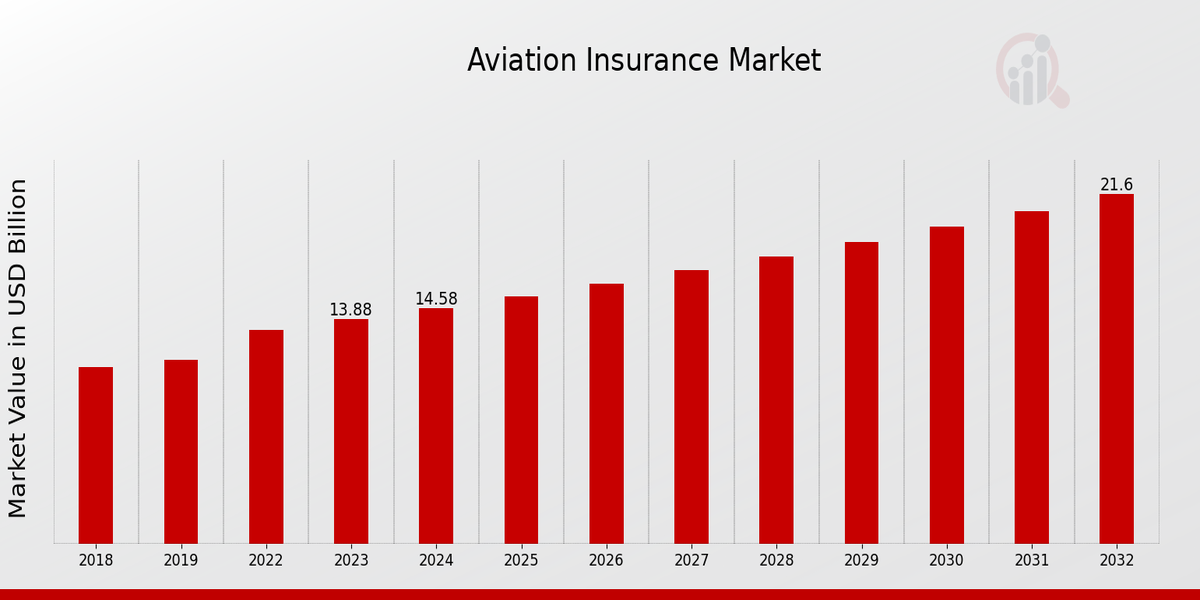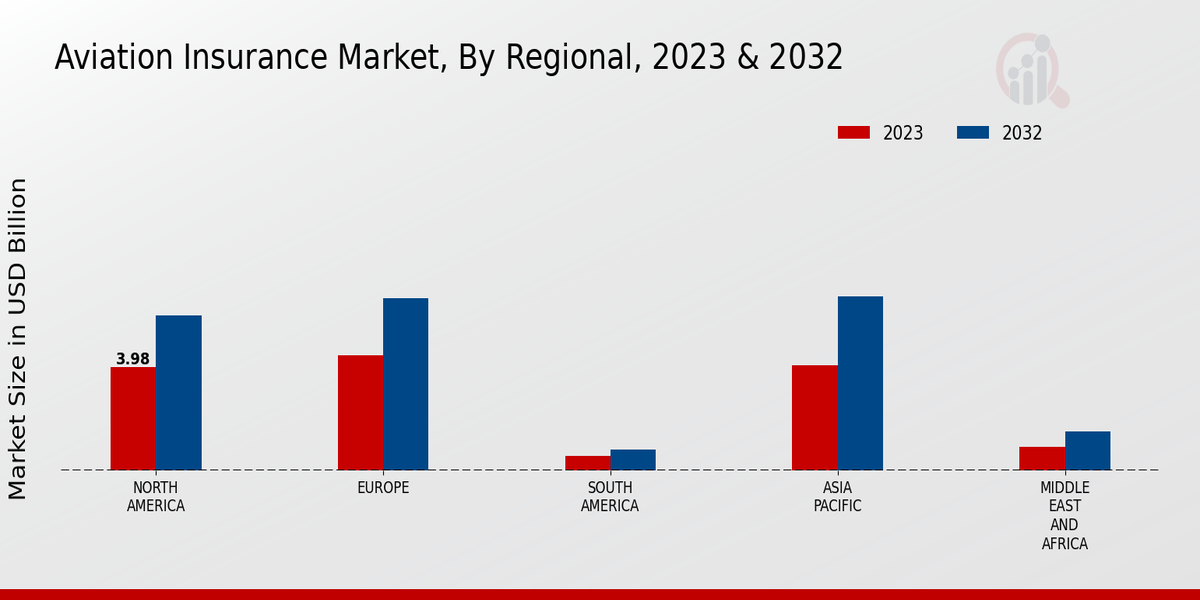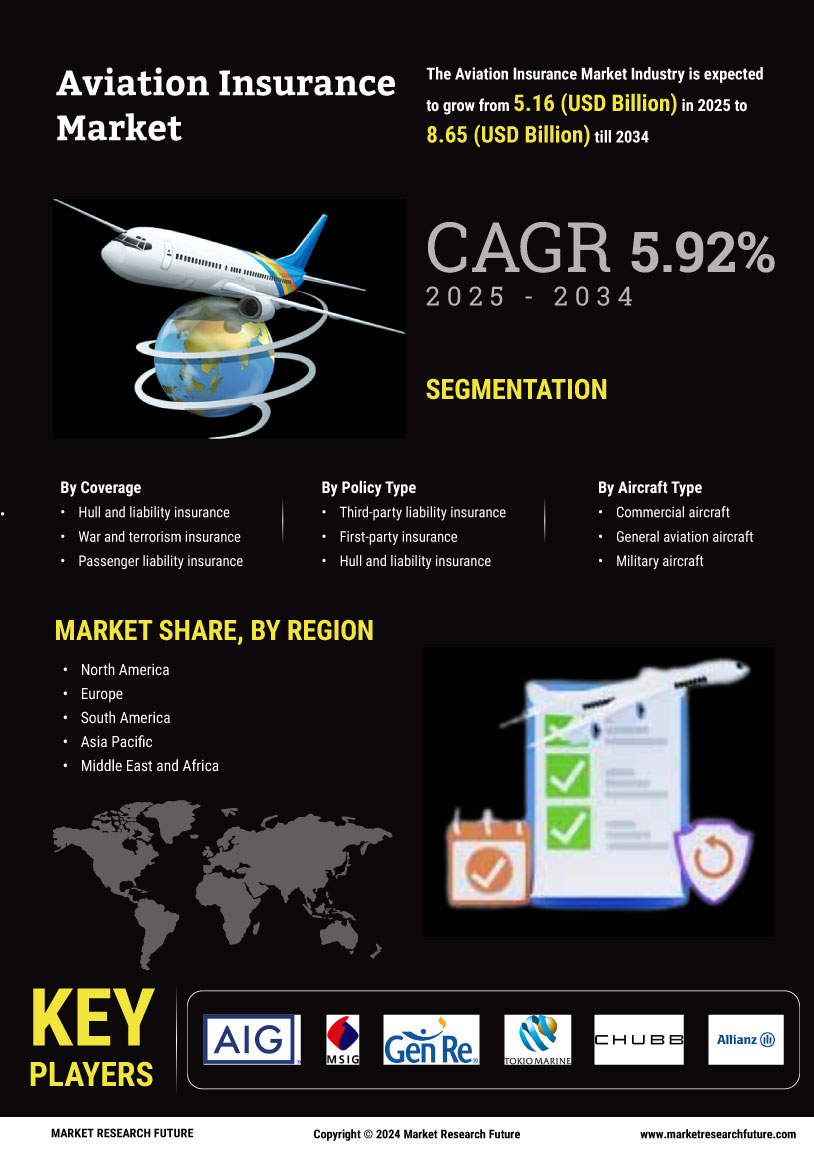Global Aviation Insurance Market Overview
Aviation Insurance Market Size was estimated at 4.87 (USD Billion) in 2024. The Aviation Insurance Market Industry is expected to grow from 5.16 (USD Billion) in 2025 to 8.65 (USD Billion) till 2034, exhibiting a compound annual growth rate (CAGR) of 5.92% during the forecast period (2025 - 2034).
Key Aviation Insurance Market Trends Highlighted
The aviation insurance market is experiencing significant growth due to increasing air traffic, rising aircraft values, and growing concerns about potential risks. Key market drivers include the expansion of the aviation industry, technological advancements in aircraft, and heightened regulatory compliance. Opportunities for growth lie in the development of innovative insurance products, expansion into emerging markets, and the provision of value-added services to customers. Recent trends in the market include the increasing adoption of digital technologies, the use of data analytics to assess risks and set premiums, and a focus on sustainability and environmental protection. The market is expected to witness continued growth in the coming years as the aviation industry continues to expand and evolve.

Source: Primary Research, Secondary Research, MRFR Database and Analyst Review
Aviation Insurance Market Drivers
Growing Air Travel Demand
Introduction The aviation insurance market is poised to grow in the next decade, primarily due to the steady increase in air travel demand. According to a report by IATA, the number of air passengers is expected to rise up to 8.2 billion in 2037 from 4.5 billion recorded in 2019. As the demand for air travel rises, the demand for aviation insurance by airlines and other major companies in the aviation industry will also surge to protect these airlines from the risk that comes with the higher level of air transport.
Some of the key factors that drive up the demand for flight in the world today include an increase in the number of middle-class people in the population and a rise in the number of low-cost airlines that are now able to charge a lower fare that is comparable to bus fare. In the new decade, airlines use lower cost, improved services, and packages such as choice of meals, provision of entertainment, and other utility services to remain competitively relevant.
The growth in the number of travelers opting to use the plane for their travels, though a more expensive choice, will have an impact on the aviation insurance market in several ways. It will lead to a rise in the premiums charged for the policy, and the companies will also make a higher profit as more companies shift to using flights to deliver their goods from one destination to another.
Rising Cost of Aviation Claims
Another factor that is expected to cause growth in the aviation insurance market is the rising cost of aviation claims. In recent years, the cost of aviation claims has been rising due to a number of factors. First, the complexity of aircraft is increasing, making it more difficult and, hence, expensive to repair them after an accident. The increased complexity of aircraft is thus increasing the cost of claims to the insurance companies. In addition, the number of air accidents is rising, which, in turn, is raising the cost of claims.
The increasing number of accidents is not caused by one factor but by a number of factors, including the increase in the number of aircraft in operation and the complexity of air traffic control systems. The increasing cost of claims is expected to result in increased premiums for aviation insurance policies. Aviation insurance companies will benefit because they will be able to charge more for their products.
Increased Regulation of the Aviation Industry
The rising regulation of the aviation industry is also a major driver of the aviation insurance market’s growth. Governments across the world are increasingly regulating the aviation industry to enhance safety and security. This increased regulation is contributing to the greater demand for aviation insurance as airlines and other industry businesses work to comply with new regulations. The greater regulation of the aviation industry is likely to have a positive impact on the aviation insurance market.
As governments across the globe execute new regulations, the demand for aviation insurance will surge. This will result in the increased premiums of aviation insurance and the higher profitability of aviation insurance companies.
Aviation Insurance Market Segment Insights
Aviation Insurance Market Coverage Insights
The Coverage segment in the Aviation Insurance Market is classified into Hull and liability insurance, War and terrorism insurance, Passenger liability insurance, and Aircraft damage coverage. The Hull and liability insurance segment dominated the market in 2023, and it will continue to hold the largest share in the forthcoming years. The segment growth is attributed to the increasing demand for coverage that helps in incurring losses due to physical damage to the aircraft and legal liabilities on the occurrence of accidents. The War and terrorism insurance segment is the second major product of aviation insurance.
The increasing geopolitical issues and the threat of terrorism have fuelled the demand for coverage. This segment is also expected to witness a notable growth in the market. The Passenger liability insurance segment is concerned with the coverage of the legal liabilities of airlines towards passengers in the case of accidents, injuries, or other problems. Thus, the segment accounted for a major share of the market and is anticipated to witness steady growth in the future. The Aircraft damage coverage segment is an important share of the market that provides insurance for the damage caused to the aircraft due to various reasons, such as weather events, mechanical failures, and accidents.
With a rapidly increasing number of aircraft combined with extreme weather events, the demand for this insurance is estimated to rise, making it the fastest-growing segment of this market. Overall, the Coverage segment of the Global Aviation Insurance Market is projected to witness substantial growth in the forthcoming years along with the increased number of aircraft, rising geopolitical issues, and the growing importance of insurance.
Aviation Insurance Market, By Coverage 2023 & 2032

Source: Primary Research, Secondary Research, MRFR Database and Analyst Review
Aviation Insurance Market Policy Type Insights
The Aviation Insurance Market is segmented by Policy Type into Third-party liability insurance, First-party insurance, and Hull and liability insurance. Among these segments, Third-party liability insurance is expected to hold the largest market share in 2023, owing to the increasing demand for coverage against third-party claims in the event of an accident. First-party insurance is also expected to witness significant growth, as it provides coverage for the policyholder's own aircraft and its contents. Hull and liability insurance, which offers a combination of coverage for both the aircraft and third-party claims, is expected to have a moderate growth rate.
Aviation Insurance Market Aircraft Type Insights
Aircraft Type is a key segment of the Aviation Insurance Market, offering insights into the varying insurance needs of different aircraft types. Commercial aircraft, including passenger planes and cargo carriers, account for a significant share of the market. In 2023, the commercial aircraft segment is valued at USD 7.2 billion and is projected to grow at a CAGR of 5.3%, reaching USD 11.2 billion by 2032. General aviation aircraft, used for private and recreational purposes, also contribute to the market, with a valuation of USD 3.6 billion in 2023 and an anticipated CAGR of 4.5%, reaching USD 5.4 billion by 2032. Military aircraft insurance is driven by government contracts and geopolitical dynamics, with a current market value of USD 2.1 billion and a projected CAGR of 4.7%, leading to a valuation of USD 3.2 billion by 2032. Unmanned aerial vehicles (UAVs) are gaining traction in commercial and military applications, with their insurance segment poised for growth. In 2023, the UAV insurance market is valued at USD 980 million and is expected to expand at a CAGR of 6.5%, reaching USD 1.6 billion by 2032.
Aviation Insurance Market Regional Insights
The regional segmentation of the Aviation Insurance Market offers valuable insights into the geographical distribution of market growth and opportunities. North America holds a dominant position in the market, accounting for a significant share of the global revenue in 2023. This dominance is driven by factors such as the presence of major aviation hubs, a well-established insurance industry, and increasing demand for aviation insurance coverage. Europe follows closely behind North America, with a substantial market share attributed to the presence of leading aviation insurance providers and a growing aerospace industry. The Asia-Pacific (APAC) region is projected to experience the highest growth rate during the forecast period, owing to the rapid expansion of the aviation sector and increasing awareness of aviation insurance among businesses. South America and the Middle East and Africa (MEA) regions also present growth potential, driven by the development of their aviation industries and the increasing demand for aviation insurance coverage in these emerging markets.
Aviation Insurance Market, by Region 2023 & 2032

Source: Primary Research, Secondary Research, MRFR Database and Analyst Review
Aviation Insurance Market Key Players And Competitive Insights
Major players in the aviation insurance market are constantly striving to gain a competitive edge by introducing innovative products and services, expanding their geographical reach, and forming strategic partnerships. Leading Aviation Insurance Market players are investing heavily in research and development to create cutting-edge solutions that meet the evolving needs of the market. The competitive landscape is characterized by intense competition, with established players trying to maintain their market share while new entrants try to disrupt the market. Mergers and acquisitions are common in the Aviation Insurance Market industry as companies seek to consolidate their position and expand their capabilities. Alliances and partnerships are also prevalent as companies collaborate to offer complementary products and services to customers. A leading company in the Aviation Insurance Market is Allianz. The company provides a comprehensive range of aviation insurance products and services, including liability, hull, and war risk insurance. Allianz has a global presence, with operations in over 100 countries. The company's financial strength and stability make it a trusted partner for airlines, airports, and other aviation businesses. Allianz is committed to providing innovative solutions and exceptional customer service, which has helped it maintain its position as a leader in the Aviation Insurance Market.
A notable competitor in the Aviation Insurance Market is AIG. The company offers a wide range of aviation insurance products and services, including property, liability, and accident insurance. AIG has a strong global presence, with operations in over 130 countries. The company's financial strength and stability make it a reliable partner for aviation businesses. AIG is known for its expertise in risk management and its ability to tailor insurance solutions to the specific needs of its clients. The company's commitment to innovation and customer satisfaction has helped it gain a significant market share in the Aviation Insurance Market.
Key Companies in the Global Aviation Insurance Market Include
- AIG
- Mitsui Sumitomo Insurance Group
- General Re (Berkshire Hathaway)
- Tokio Marine Holdings
- Chubb
- Allianz SE
- AXA
- Sompo Holdings
- HDI Global
- Munich Re
- Everest Re Group
- Bermudan re/insurers
- Swiss Re
Aviation Insurance Industry Developments
In recent years, there has been a growing demand for aviation insurance due to the increasing number of air travelers and the rising value of aircraft. The market is driven by factors such as the increasing awareness of the importance of insurance, the growing number of airlines and airports, and the increasing frequency of air travel. Some of the key recent developments in the aviation insurance market include the launch of new products and services by major insurers, the entry of new players into the market, and the increasing use of technology to improve risk assessment and claims processing. The market is expected to continue to grow in the coming years, with a CAGR of 5.04% from 2024 to 2032, reaching a value of USD 21.6 billion by 2032.
Aviation Insurance Market Segmentation Insights
Aviation Insurance Market Coverage Outlook
- Hull and liability insurance
- War and terrorism insurance
- Passenger liability insurance
- Aircraft damage coverage
Aviation Insurance Market Policy Type Outlook
- Third-party liability insurance
- First-party insurance
- Hull and liability insurance
Aviation Insurance Market Aircraft Type Outlook
- Commercial aircraft
- General aviation aircraft
- Military aircraft
- Unmanned aerial vehicles (UAVs)
Aviation Insurance Market Regional Outlook
- North America
- Europe
- South America
- Asia Pacific
- Middle East and Africa
| Report Attribute/Metric |
Details |
|
Market Size 2024
|
USD 4.87 Billion
|
|
Market Size 2025
|
USD 5.16 Billion
|
|
Market Size 2034
|
USD 8.65 Billion
|
|
Compound Annual Growth Rate (CAGR)
|
5.92% (2025-2034)
|
| Report Coverage |
Revenue Forecast, Competitive Landscape, Growth Factors, and Trends |
|
Base Year
|
2024
|
|
Market Forecast Period
|
2025-2034
|
|
Historical Data
|
2020-2023
|
| Market Forecast Units |
USD Billion |
| Key Companies Profiled |
AIG, Mitsui Sumitomo Insurance Group, General Re (Berkshire Hathaway), Tokio Marine Holdings, Chubb, Allianz SE, AXA, Sompo Holdings, HDI Global, Munich Re, Everest Re Group, Bermudan re/insurers, Swiss Re |
| Segments Covered |
Coverage, Policy Type, Aircraft Type, Regional |
| Key Market Opportunities |
Emerging technologies.Remotely piloted aircraft systems.Cyber risks Climate change resilience.Sustainable aviation practices. |
| Key Market Dynamics |
Key Market Dynamics.Rising demand for new aircraft.Increasing awareness of aviation risks.Growing adoption of drones.Evolving regulatory landscape.Advancements in technology and data analytics |
| Countries Covered |
North America, Europe, APAC, South America, MEA |
Frequently Asked Questions (FAQ) :
The global aviation insurance market is expected to reach USD 8.65 billion by 2034, exhibiting a CAGR of 5.92% during the forecast period (2025-2034).
North America is expected to dominate the global aviation insurance market throughout the forecast period, owing to the presence of major aviation hubs, stringent regulatory frameworks, and a high concentration of aircraft manufacturers.
The growth of the global aviation insurance market is primarily driven by the increasing demand for air travel, rising air traffic volumes, and growing concerns over aviation safety and liability.
Aviation insurance covers various aspects of aviation operations, including aircraft hull and liability, passenger liability, and airport liability.
Major players in the global aviation insurance market include Allianz SE, AIG, Berkshire Hathaway, Chubb, and Zurich Insurance Group.
The global aviation insurance market is expected to witness steady growth in the coming years, driven by increasing air travel demand and growing concerns over aviation safety and liability.
The global aviation insurance market faces challenges such as volatile economic conditions, fluctuations in exchange rates, and increasing frequency and severity of natural disasters.
Key trends shaping the global aviation insurance market include the adoption of digital technologies, the rise of parametric insurance, and the increasing focus on sustainability.
Aviation insurance is subject to various regulatory and compliance requirements, including international treaties, national laws, and industry standards.
Emerging technologies such as blockchain, telematics, and artificial intelligence are transforming the global aviation insurance market by improving risk assessment, claims processing, and overall efficiency.

















